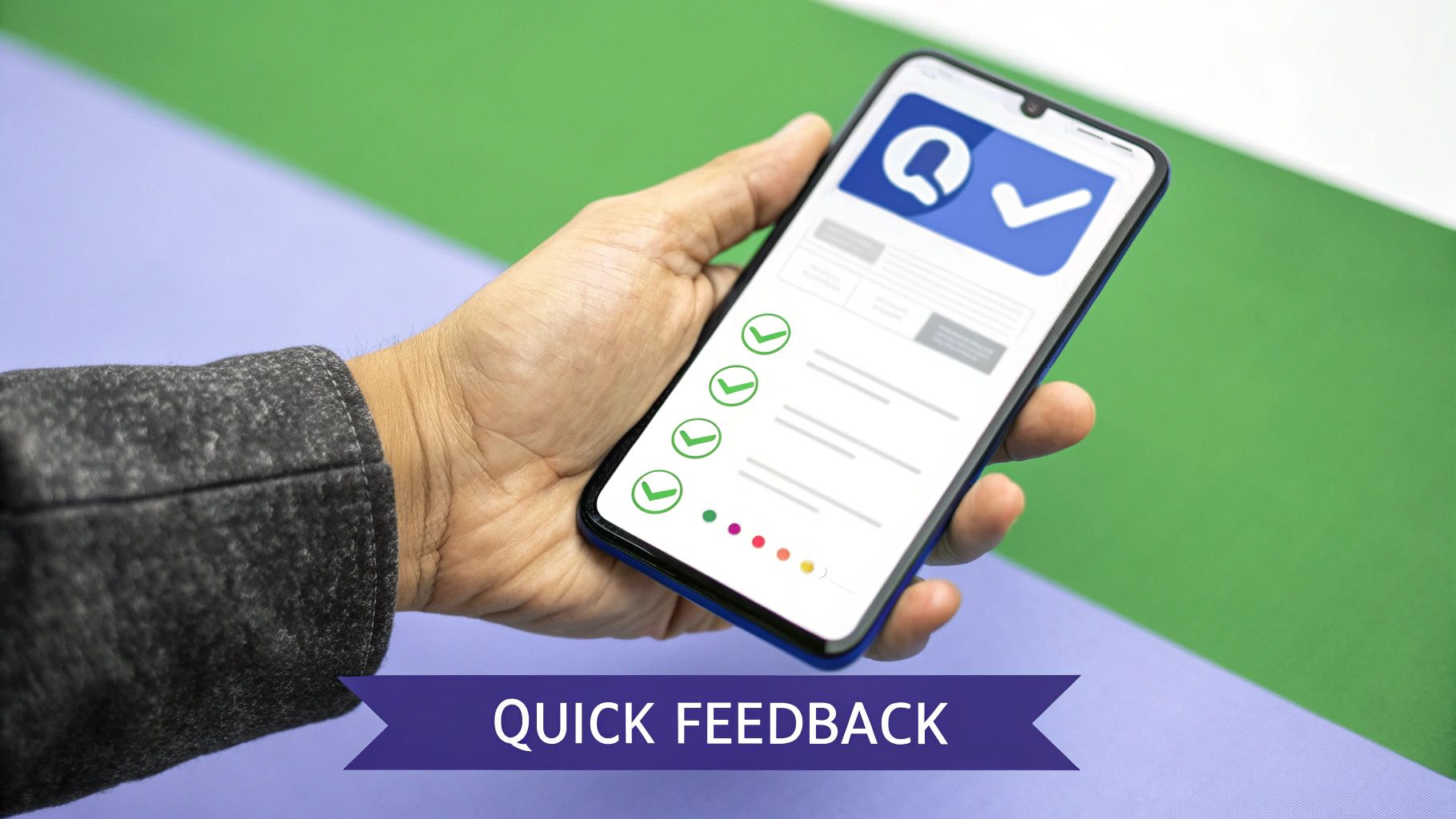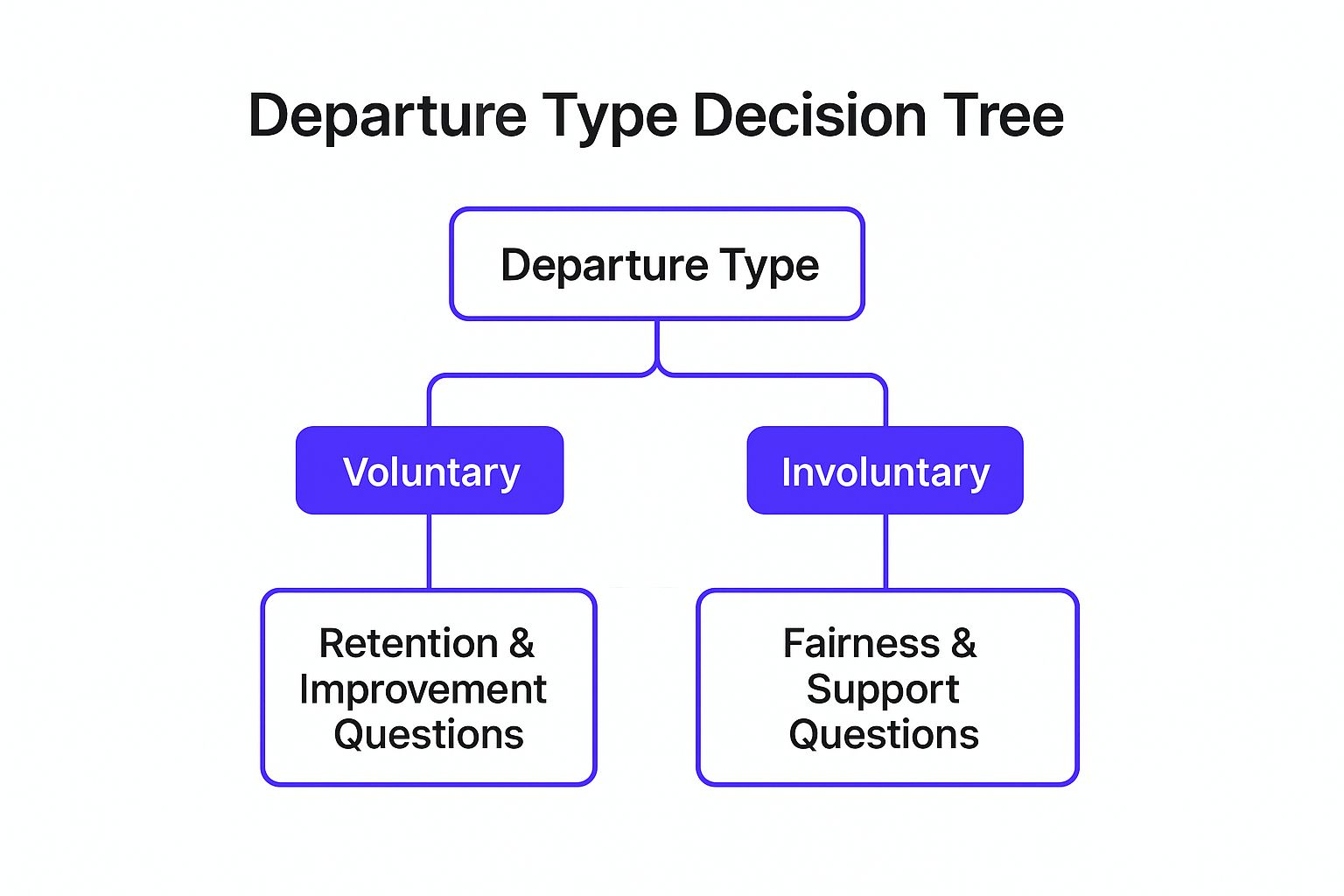6 SaaS Exit Survey Example Templates to Use in 2025
Discover 6 powerful SaaS exit survey example templates. Learn to analyze feedback, reduce churn, and improve retention with our expert breakdown.

Losing a customer or employee is never easy, but it presents a critical opportunity for growth. The final interaction, the exit survey, is far more than a procedural formality. It's a strategic tool that, when designed correctly, uncovers actionable intelligence to improve product-market fit, reduce churn, and enhance the overall customer or employee experience. A well-crafted exit survey example moves beyond the generic "Why are you leaving?" to diagnose specific pain points, validate your value proposition, and reveal competitor strengths.
This article provides a curated collection of effective exit survey templates and question sets, tailored for different contexts from SaaS cancellation flows to employee departures. We won't just show you what to ask; we will break down the strategic thinking behind each question. For every exit survey example, you will find a deep analysis of its structure, tactical insights into why it works, and actionable takeaways you can immediately apply. You'll learn how to transform this final touchpoint from a simple data collection exercise into a powerful engine for retention and strategic improvement. Let's explore the examples that will help you capture the insights you're currently missing.
1. The Standard Employee Exit Survey
The Standard Employee Exit Survey is the foundational model for gathering feedback from departing employees. It’s a comprehensive, structured questionnaire designed to systematically cover the key facets of the employee journey, from day-to-day responsibilities and team dynamics to broader organizational factors like culture and compensation. This method provides a reliable, data-driven overview of why people leave, creating a crucial feedback loop for improving retention.

Pioneered by organizations like SHRM and Gallup, and refined by global corporations such as Microsoft and Google, this traditional survey format serves as an essential diagnostic tool. It moves beyond a single "Why are you leaving?" question to dissect the employee experience across multiple dimensions. This approach allows HR and leadership to spot trends, identify problematic managers or departments, and make informed decisions to enhance the workplace environment.
Strategic Analysis
The power of this exit survey example lies in its standardization. By asking every departing employee the same core set of questions, organizations can aggregate data over time and benchmark internally. For example, Google’s People Operations team uses exit data to identify attributes of high-performing managers and teams, which then informs their management training programs.
Key Insight: A standardized survey creates a consistent dataset. This allows for powerful longitudinal analysis, enabling you to track how changes in policy, leadership, or culture impact employee satisfaction and turnover rates over months and years.
This method effectively balances quantitative and qualitative feedback. Likert scales (e.g., "Rate your satisfaction from 1 to 5") provide easy-to-analyze metrics, while open-ended questions offer context and specific examples that bring the data to life.
Actionable Takeaways
To effectively implement a standard employee exit survey, consider these tactics:
- Ensure Anonymity: Guaranteeing confidentiality is non-negotiable for honest feedback. Use a trusted third-party platform or an internal system that protects the employee’s identity. For a deeper understanding of how to build trust, you can find valuable insights about creating an anonymous feedback form on Surva.ai.
- Balance Length and Depth: Keep the survey focused. Aim for 15-20 questions to avoid survey fatigue while still gathering sufficient detail. Group questions by themes like Management, Role, and Compensation.
- Likert Scales: For rating satisfaction with benefits, management, or work-life balance.
- Multiple Choice: To categorize the primary reason for leaving (e.g., Better Opportunity, Compensation, Relocation).
- Open-Ended: For specific feedback, such as "What could your manager have done better to support you?"
2. The Pulse Exit Survey
The Pulse Exit Survey is a condensed, high-impact alternative to traditional, lengthy questionnaires. It prioritizes speed and completion rates by focusing on just 5-7 critical questions designed to capture the most essential feedback about why an employee is leaving. This streamlined approach delivers targeted, actionable insights without causing survey fatigue, making it ideal for fast-paced environments.

Popularized by tech startups and modern HR platforms like Culture Amp, the pulse method is built for agility. Companies like Spotify and Slack have championed this approach, using quick feedback forms to gather high-quality data from nearly every departing employee. Instead of a deep dive, it acts as a sharp, diagnostic snapshot, identifying the most significant pain points with minimal friction.
Strategic Analysis
The core strength of this exit survey example is its high signal-to-noise ratio. By eliminating non-essential questions, it forces a focus on what truly matters, ensuring the feedback collected is potent and directly relevant. Spotify’s 6-question survey, for example, is designed to be completed in under three minutes, dramatically increasing the likelihood of participation from busy departing team members.
Key Insight: Brevity drives participation. A short, focused survey respects the departing employee's time, leading to higher completion rates and more immediate, candid feedback that can be acted upon quickly.
This model excels at capturing the "one big thing" that influenced an employee's decision. It is less about comprehensive data aggregation and more about identifying critical, time-sensitive issues, like a toxic team culture or a major compensation gap, before they escalate.
Actionable Takeaways
To effectively deploy a pulse exit survey, focus on precision and timing:
- Prioritize Ruthlessly: Limit yourself to 5-7 questions. Each one must earn its place by targeting a crucial area of the employee experience.
- Deploy Immediately: Send the survey link as soon as a resignation is formally announced. The reasons for leaving are freshest at this moment, leading to more accurate responses.
- Primary Reason: Use a single-choice question to identify the main driver for departure (e.g., "What is the single most important reason you are leaving?").
- Recommendation Score: Include an eNPS-style question like, "How likely are you to recommend our company as a place to work?"
- Specific Improvement: Ask for one targeted suggestion, such as, "What is the one thing we could change to improve the employee experience?"
3. The Role-Specific Exit Survey
The Role-Specific Exit Survey drills down into the unique experiences of employees in particular positions or departments. Instead of a one-size-fits-all approach, these questionnaires are tailored to uncover challenges, resource gaps, and opportunities relevant to a specific function, such as engineering, sales, or nursing. This method provides highly targeted, actionable feedback that a general survey might miss.
This specialized exit survey example is frequently used by organizations with diverse and distinct roles, where the daily reality of a software engineer is vastly different from that of a sales representative. Companies like Netflix and McKinsey, along with large hospital systems, use this model to diagnose role-specific friction points. For instance, a nurse’s exit survey might focus on patient load and access to medical equipment, while a consultant's would probe project allocation and client management.
Strategic Analysis
The strategic value of this survey lies in its precision. By customizing questions, organizations can move beyond generic feedback to identify concrete operational issues within specific teams or functions. Netflix's engineering-specific surveys, for example, can uncover issues with a particular tech stack or development process, providing data that leads directly to workflow improvements for that department.
Key Insight: Role-specific surveys generate granular data that links directly to departmental operations. This allows leadership to implement targeted interventions that have a measurable impact on the retention and performance of employees in that specific role.
This approach is particularly powerful for understanding why high-value, specialized talent leaves. It connects turnover directly to the tools, processes, and support structures that define a particular job, making the feedback immediately relevant to department heads.
Actionable Takeaways
To create an effective role-specific exit survey, implement these tactics:
- Collaborate with Department Heads: Work directly with managers and senior team members to identify the most critical questions. They know the role’s unique challenges, from specific software tools to team dynamics.
- Focus on Role-Specific Factors: Include questions that a general survey wouldn’t. Ask about the adequacy of sales enablement tools for a sales role, or the clarity of project specs for a developer role.
- Investigate Career Pathways: Tailor questions about career development to the specific trajectory of that position. For a junior analyst, ask about mentorship opportunities and paths to senior analyst roles.
- Scope Creep: Was the role clearly defined, or did responsibilities expand unexpectedly?
- Performance Metrics: Were the KPIs for success clear, fair, and attainable?
- Resources: Did you have the necessary tools, budget, and training to succeed in your specific function?
4. The Stay Interview Style Exit Survey
The Stay Interview Style Exit Survey reframes the departure conversation from a retrospective analysis to a forward-looking, preventative measure. Instead of simply asking why an employee is leaving, this format focuses on what could have been done differently to encourage them to stay. It’s a proactive approach designed to gather intelligence that can be used immediately to improve retention among the current workforce.
This model flips the traditional exit survey on its head. It’s less about documenting a single departure and more about diagnosing potential flight risks across the organization. Companies with famously strong retention cultures, like Zappos and Southwest Airlines, integrate this philosophy into their departure processes, turning an exit into a crucial learning opportunity for future employee engagement strategies.
Strategic Analysis
The strategic value of this exit survey example lies in its focus on actionable retention drivers. By mirroring the questions used in a "stay interview," it directly asks about the specific factors, moments, or unfulfilled needs that led to the employee's decision to leave. This yields highly specific feedback on areas like career development, management support, or work-life balance that can be addressed to prevent similar departures.
Key Insight: This approach shifts the focus from "Why did you leave?" to "What would have convinced you to stay?". This subtle change generates more constructive and solution-oriented feedback that leadership can act upon to improve the experience for remaining employees.
This method is particularly powerful for understanding nuanced issues that a standard survey might miss. It gets to the heart of employee motivation and uncovers the tipping points in an employee's journey, providing a clear roadmap for what changes would be most impactful.
Actionable Takeaways
To implement a stay interview style exit survey effectively, use these tactics:
- Frame Questions for the Future: Phrase questions hypothetically to encourage constructive feedback. For instance, "What professional development opportunity, if offered, would have significantly impacted your decision to stay?"
- Identify Specific Turning Points: Ask about key moments that influenced their decision. A question like, "Was there a specific project, event, or interaction that made you first consider looking for a new role?" can reveal critical breakdowns in the employee experience.
- Focus on What Was Missing: Directly inquire about unmet needs. Questions about career pathing, flexibility, and management coaching are essential here.
- Use Open-Ended Questions: This style thrives on detailed, qualitative feedback. Leverage open-ended questions to allow departing employees to explain their reasoning in their own words. For more inspiration, you can find a wealth of open-ended survey question examples on Surva.ai.
5. The Digital-First Exit Survey
The Digital-First Exit Survey represents a modern evolution of employee feedback, leveraging technology to create a more engaging, accessible, and efficient experience. This approach moves beyond static forms, incorporating mobile optimization, interactive elements, and automated workflows. It is designed for the contemporary workforce, meeting employees where they are: on their digital devices.

Popularized by tech-forward companies and SaaS platforms like Typeform and SurveyMonkey, this method is exemplified by the systems at Amazon and Uber. These companies use automated, mobile-optimized platforms to deliver timely surveys that are easy to complete on any device. This digital-first mindset ensures higher completion rates and faster data collection, allowing for more immediate analysis and action.
Strategic Analysis
The core advantage of this exit survey example is its focus on user experience and automation. By making the survey intuitive and accessible, organizations reduce friction and encourage more thoughtful responses. Conditional logic, for instance, allows the survey to adapt in real-time, asking relevant follow-up questions based on previous answers, thus creating a personalized and more insightful feedback path.
Key Insight: A digital-first approach transforms the exit survey from a static HR checklist into a dynamic conversation. It boosts engagement through interactivity and provides cleaner, instantly analyzable data, accelerating the feedback-to-action cycle.
This method also opens the door to richer forms of feedback. Instead of just text, organizations can incorporate different media. For those aiming to modernize the process, exploring how to create video surveys can offer a compelling alternative to traditional methods, allowing employees to record short video responses that capture tone and nuance.
Actionable Takeaways
To implement an effective digital-first exit survey, focus on technology and user-centric design:
- Prioritize Mobile-First Design: Ensure the survey is fully responsive and functions flawlessly on smartphones and tablets, as many employees will complete it on these devices.
- Use Conditional Logic: Personalize the survey flow. If an employee cites "Management" as their reason for leaving, automatically display a specific set of questions about their manager.
- Incorporate Progress Indicators: A simple progress bar manages expectations and reduces survey abandonment by showing the employee how much is left to complete.
- Automate Delivery and Reminders: Trigger the survey automatically upon an employee's final day and send gentle, automated reminders to those who haven't completed it to maximize response rates. For more guidance on building the survey itself, you can get additional details on designing your exit survey form with Surva.ai.
6. The Voluntary vs. Involuntary Exit Survey
The Voluntary vs. Involuntary Exit Survey is a dual-approach system that acknowledges a critical reality: the reasons and emotions behind an employee's departure drastically change the nature of useful feedback. This model uses different survey formats and questions depending on whether the exit is voluntary (the employee chose to leave) or involuntary (the company initiated the termination). This strategic separation ensures the feedback collected is relevant, sensitive, and actionable for each specific circumstance.
This decision tree visualizes the core logic of this dual-approach exit survey example, guiding HR on which question path to follow based on the type of departure.

The flowchart illustrates how the initial 'Departure Type' decision dictates a shift in focus from retention-focused questions for voluntary exits to process-focused questions for involuntary ones.
Pioneered by large, complex organizations like General Electric and Procter & Gamble, this differentiated process recognizes that lumping all departures into one category contaminates the data. A laid-off employee's perspective on company processes is vastly different from that of an employee leaving for a better salary. By separating these streams, you get clearer, more targeted insights into both your retention strategy and your termination procedures.
Strategic Analysis
The strategic advantage of this approach is its precision. For voluntary departures, the survey can dive deep into push-and-pull factors: management effectiveness, career growth opportunities, and compensation benchmarks. The goal is to uncover preventable reasons for turnover. For involuntary exits, the focus shifts to process fairness, clarity of communication, and the employee's treatment during a difficult time, which is crucial for mitigating legal risks and protecting employer brand reputation.
Key Insight: Segmenting exit surveys by departure type allows you to isolate variables. You can analyze retention issues separately from layoff or performance-management process issues, preventing one from skewing the data of the other and leading to more accurate conclusions.
This method transforms the exit survey from a one-size-fits-all form into a highly contextual diagnostic tool. It allows organizations to ask the right questions to the right people at the right time, maximizing the value of the feedback gathered from every single departure.
Actionable Takeaways
To implement a differentiated exit survey system, focus on clarity and empathy:
- Voluntary: Focus on role satisfaction, manager support, culture, compensation, and reasons for seeking new opportunities.
- Involuntary: Focus on the perceived fairness of the process, clarity of communication, resources provided (e.g., severance), and treatment by HR and management.
Exit Survey Types Comparison
Turning Feedback into Your Ultimate Growth Engine
Throughout this guide, we've deconstructed various exit survey example formats, moving far beyond generic templates to uncover the strategic mechanisms that turn departing user feedback into a powerful engine for growth and retention. The goal isn't just to ask "Why are you leaving?" but to build a system that diagnoses issues, validates hypotheses, and informs your product roadmap with unparalleled clarity.
From the straightforward efficiency of a standard survey to the proactive, relationship-building nature of a stay interview-style approach, each example offers a unique lens through which to view churn. We've seen how segmenting feedback for voluntary versus involuntary churn can prevent you from acting on irrelevant data, and how tailoring questions to specific user roles or personas can yield highly specific, actionable insights.
The central lesson is that a well-designed exit survey is not a passive data collection tool; it is an active, strategic asset. It's the final, and often most honest, conversation you will have with a customer, providing a rare opportunity to capture unfiltered truth.
Your Actionable Blueprint for Exit Survey Mastery
To translate these concepts into immediate action, focus on these core principles. Think of this as your strategic checklist for implementing a world-class feedback loop.
- Start with a Clear Objective: Before you write a single question, define what you want to learn. Are you diagnosing a feature gap? A pricing issue? A poor onboarding experience? Your objective dictates the entire structure of your exit survey example.
- Segment, Segment, Segment: Do not treat all churning users the same. At a minimum, separate feedback by user persona, plan level, and tenure. This segmentation is what turns vague feedback like "it was too expensive" into a specific insight like "our new power users on the pro plan don't see value in Feature X after 90 days."
- Prioritize Action Over Volume: It's better to ask five highly specific, actionable questions than twenty generic ones. Each question should be tied directly to a potential action your team can take, whether it's revising your pricing page, creating a new tutorial, or prioritizing a feature on your roadmap.
- Close the Loop (When Possible): For high-value customers or those who provide detailed feedback, consider a personal follow-up. This not only provides deeper insights but can sometimes win back a customer or, at the very least, turn a detractor into a future advocate.
By embracing these strategies, you shift your organization's perspective on churn. It's no longer just a metric to report but a rich source of intelligence to be mined. Every cancellation becomes a lesson, and every piece of feedback is a signpost pointing toward a more resilient, customer-centric product. The examples we have explored are your templates for building this critical system, ensuring you’re not just watching customers leave, but learning from every single departure to build a business that fewer people want to walk away from.
Ready to move beyond static forms and build dynamic, intelligent feedback loops? Surva.ai empowers you to create and deploy the kind of strategic surveys we've discussed, with smart branching logic, powerful analytics, and seamless integrations. Start turning churn into your most valuable source of product intelligence today at Surva.ai.


